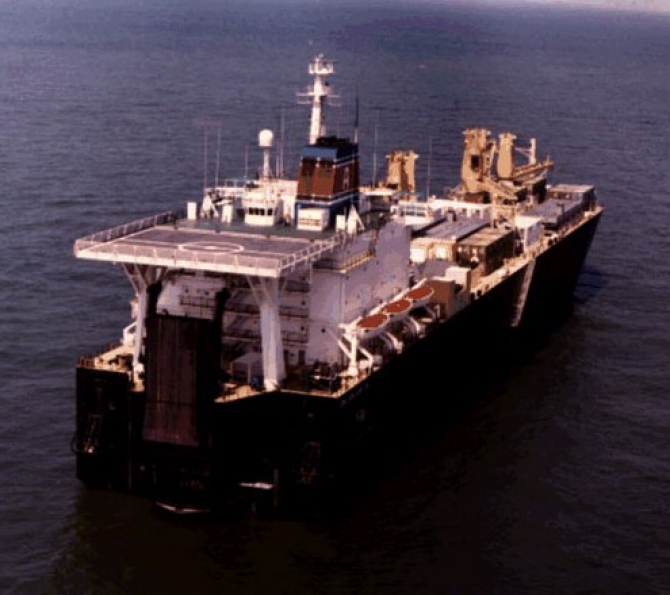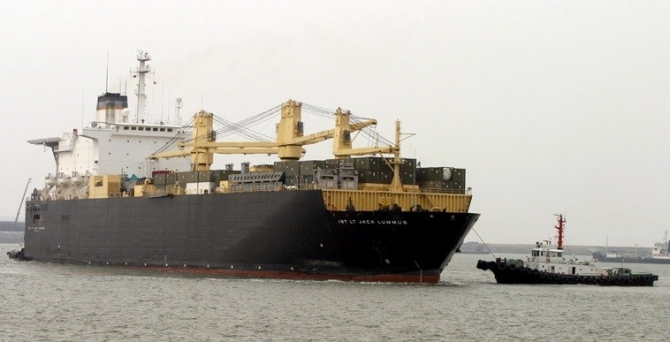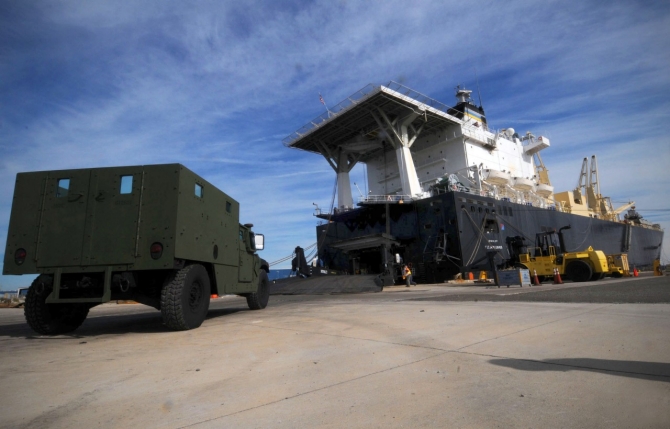1st Lt. Jack Lummus (T-AK-3011)
1986–
The first U.S. Navy ship named for 1st Lt. Andrew Jackson Lummus Jr. USMC (22 October 1915-8 March 1945) who was posthumously awarded the Medal of Honor for his actions during combat on Iwo Jima.
(T-AK-3011; displacement 19,588 (light) 46,111 (full); length 671'; beam 106’; draft 30’; speed 17.7 knots; complement 30; class 2nd Lt. John P. Bobo).
1st Lt. Jack Lummus (T-AK-3011) -- built by General Dynamics Quincy Shipbuilding Division, Quincy, Mass. -- was acquired by the Navy under a long-term charter on 6 March 1986; placed in service under the direction of the Military Sealift Command (MSC) as 1st Lt. Jack Lummus to be operated by American Overseas Marine Corporation; purchased by MSC on 17 January 2006.


On 26 December 2004 a tsunami that stemmed from an underwater earthquake off Indonesia devastated South Asia. In response, as part of Operation Unified Assistance, the Navy deployed six Maritime Prepositioning Ships -- 1st Lt. Jack Lummus, 1st Lt. Harry L. Martin (T-AK-3015), Maj. Stephen W. Pless (T-AK-3007), Cpl. Louis J. Hauge Jr. (T-AK-3000), PFC James Anderson Jr. (T-AK-3002), and 1st Lt. Alex Bonnyman (T-AK-3002). These ships, part of Maritime Prepositioning Ships Squadron 3, were collectively laden with enough equipment and supplies to support 15,000 Marines for 30 days. In addition to expeditionary Marine Corps combat equipment, the ships carried food, fuel, medical supplies, construction and road building equipment, electrical power generating equipment, airfield matting, and a Navy field hospital. Lummus and Bonnyman completed a 10-day tsunami relief operation on 1 February 2005 in the Republic of Maldives as part of Unified Assistance. The ships moored offshore from several islands in the Laamu Atoll, approximately 200 miles south of the capitol atoll of Male. Water was made using a reverse osmosis water purification system, equipment used to make potable water from seawater. The potable water was then transported from island to island by Marine Corps amphibious craft.
Following a 7.0 magnitude earthquake near Port-au-Prince, Haiti on 12 January 2010, the Navy responded by deploying assets for Operation Unified Response. 1st Lt. Jack Lummus loaded cargo on 18-19 January at Blount Island Command, Jacksonville, Fla. The ship also transported Navy lighterage - motorized and non-motorized barges - to transport the ship’s cargo to shore. Lummus arrived off Haiti on 21 January. On 25 January 1st Lt. Jack Lummus offloaded humanitarian assistance supplies from the Marine Corps and United States Agency for International Development (USAID) off Port-au-Prince. The ship’s offloading of supplies and vehicles was critical to sustaining humanitarian assistance and disaster relief operations in Haiti.

On 20 June 2013 1st Lt. Jack Lummus completed active support for exercise Dawn Blitz 2013 off the coast of San Diego, Calif. The ship operated as a training platform for the Marine Combat Logistics Regiment 17, 1st Marine Expeditionary Brigade and sailors with Naval Beach Group 1, Expeditionary Strike Group 3. 1st Lt. Jack Lummus, anchored offshore, gave Dawn Blitz participants the ability to test and train with the improved Navy Lighterage System, which enabled transportation of equipment and vehicles from ship to shore. Over seven days, sailors and marines transported rolling stock equipment, and shipping containers, staging it on board 1st Lt. Jack Lummus and then off-loading the equipment to shore. The training was designed to simulate humanitarian assistance and combat operations.
Detailed history under construction.
Christopher B. Havern Sr.
14 December 2015


